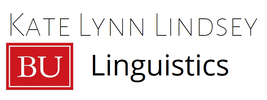Get Involved with Language Documentation and Revitalization
There are an estimated 7,000 languages in the world, each uniquely encoding the history, culture and world view of its speakers. In a rapidly changing world, linguistic diversity contributes to our sense of community and identity. In a rapidly globalizing world, linguistic diversity contributes to the safeguarding of our cultural heritage.
It is currently estimated that at least half the world's languages will disappear by the end of the century, lost to emigration, economic rationalization, and too often, systematic discrimination. This is at a rate of nearly one language every month.
What will be lost to the world if all trace of your language disappeared?
Most languages do not have a written form, so when an endangered language is no longer spoken it can take an entire cultural history with it. In too many cases these are the world's oldest living cultures - in Australia more than 90% of the 200+ aboriginal languages are either dead or endangered.
It is currently estimated that at least half the world's languages will disappear by the end of the century, lost to emigration, economic rationalization, and too often, systematic discrimination. This is at a rate of nearly one language every month.
What will be lost to the world if all trace of your language disappeared?
Most languages do not have a written form, so when an endangered language is no longer spoken it can take an entire cultural history with it. In too many cases these are the world's oldest living cultures - in Australia more than 90% of the 200+ aboriginal languages are either dead or endangered.
To FollowLanguage Documentation & Conservation
Language Documentation and Conservation - a free open-access journal published by the University of Hawai'i and available here. Also look for their International Conferences on Language Documentation and Conservation every other year in Manoa, HI.
Living Tongues Organization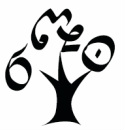
The mission of the Living Tongues Institute for Endangered Languages is to promote the documentation, maintenance, preservation, and revitalization of endangered languages worldwide through linguist-aided, community-driven multi-media language documentation projects.
The Hans Rausing Endangered Languages Project (HRELP)
HRELP provide grants for language documentation, train willing documentarians, and supports a multimedia digital archive of endangered languages.
The Endangered Language Fund (ELF)
ELF provide funding grants for language documentation and organizations / communities seeking to make use of documentation materials.
The Foundation for Endangered Languages (FEL)
FEL raises awareness of endangered languages, monitor linguistic policies and make information available about the preservation of endangered languages.
Student Advocates for Language Preservation (SALP)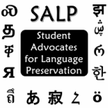
Student-founded and led since 2014, SALP is the product of years of the founders' interest in linguistics and minority rights. Seeking to address the unfortunate language loss process - in immigrant and minority communities, and languages with rapidly declining numbers of speakers - SALP works to bring the issue to the public eye, especially by encouraging students of any age to take action.
|
To ReadDying Words by Nicholas Evans
The next century will see more than half of the world’s 6,000 languages become extinct, and most of these will disappear without being adequately recorded. Written by one of the leading figures in language documentation, this fascinating book explores what humanity stands to lose as a result.
Halte à la mort des langues by Claude Hagège
«
Sait-on qu’en moyenne, il meurt environ 25 langues chaque année ? Il
existe aujourd’hui dans le monde 5 000 langues vivantes. Dans cent ans,
si rien ne change, la moitié de ces langues seront mortes. À la fin du
XXIe siècle, il devrait donc en rester 2 500 environ, et sans doute
beaucoup moins encore si l’on tient compte d’une accélération, fort
possible, du rythme de disparition. Certes, comme les civilisations, les
langues sont mortelles, et le gouffre de l’histoire est assez grand
pour toutes. Pourtant, la mort des langues a quelque chose de tout à
fait insolite, et d’exaltant quand nous nous en avisons : les langues
sont capables de résurrection ! Mais la vigilance s’impose, faute de
quoi toutes sont menacées, y compris le français. » C. H.
One Thousand Languages: Living Endangered & Lost by Peter K. Austin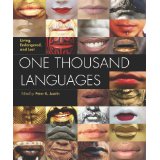
There are more than six thousand languages used around the world today, although linguists now estimate that by the year 2050 as many as half of those will be extinct. This beautifully designed, engagingly written reference takes us on a panoramic tour of the globe to explore this unique and endangered human gift. Generously illustrated throughout with color photographs, informative sidebars, and clear maps and graphics, One Thousand Languages illuminates the sources, characteristics, and interrelationships of the world's spoken tongues. It looks in detail at the eleven global languages, then delves into the major languages of each world region in turn. Each entry gives a history of the growth and development of the language, details the number of speakers, and traces its geographical spread. The volume also provides information on many extinct languages. A detailed map section tracks the migrations of the major languages, and the book also tells how to count to ten in more than 250 ways.
Language Death by David Crystal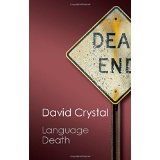
The rapid endangerment and death of many minority languages across the world is a matter of widespread concern, not only among linguists and anthropologists but among all concerned with issues of cultural identity in an increasingly globalized culture. By some counts, only 600 of the 6,000 or so languages in the world are 'safe' from the threat of extinction. A leading commentator and popular writer on language issues, David Crystal asks the fundamental question, 'why is language death so important?', reviews the reasons for the current crisis, and investigates what is being done to reduce its impact. This book contains not only intelligent argument, but moving descriptions of the decline and demise of particular languages, and practical advice for anyone interested in pursuing the subject further.
Can Threatened Languages be Saved? by Joshua Fishman (ed.)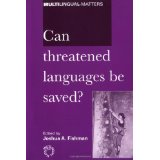
Defenders of threatened languages all over the world, from advocates of biodiversity to dedicated defenders of their own cultural authenticity, are often humbled by the dimensity of the task that they are faced with when the weak and the few seek to find a safe-harbour against the ravages of the strong and the many. This book provides both practical case studies and theoretical directions from all five continents and advances thereby the collective pursuit of "reversing language shift" for the greater benefit of cultural democracy everywhere.
Saving Languages by Lenore A Grenoble and Lindsay Whaley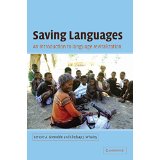
Language endangerment has been the focus of much attention and as a result, a wide range of people are working to revitalize and maintain local languages. This book serves as a general reference guide to language revitalization, written not only for linguists and anthropologists, but also for language activists and community members who believe they should ensure the future use of their languages, despite their predicted loss. Drawing extensively on case studies, it sets out the necessary background and highlights central issues such as literacy, policy decisions, and allocation of resources. Its primary goal is to provide the essential tools for a successful language revitalization program, such as setting and achieving realistic goals, and anticipating and resolving common obstacles. Clearly written and informative, Saving Languages will be an invaluable resource for all those interested in the fate of small language communities around the globe.
|
